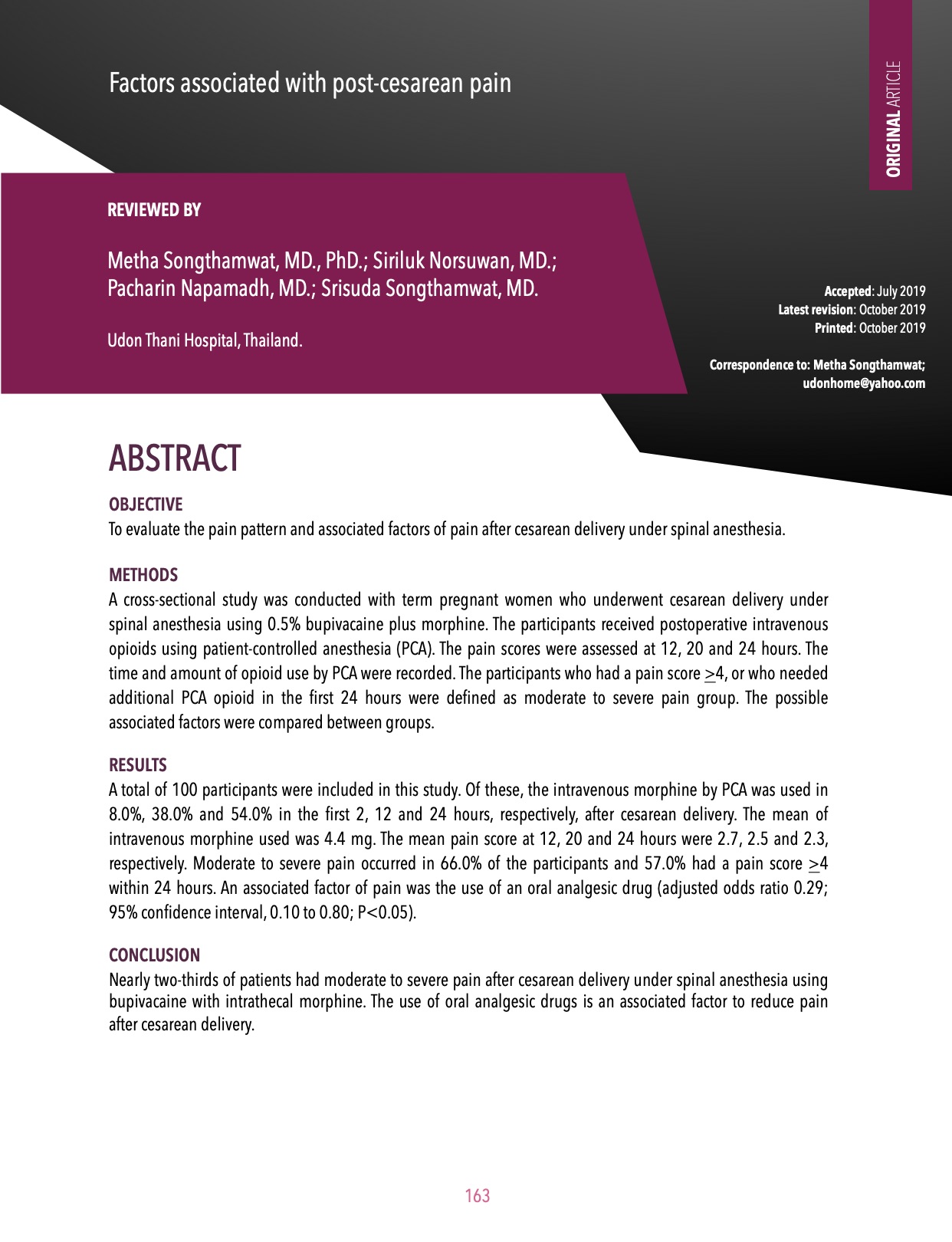Factors associated with post-cesarean pain
คำสำคัญ:
cesarean section; postoperative pain; pain score; associated factor.บทคัดย่อ
OBJECTIVE
To evaluate the pain pattern and associated factors of pain after cesarean delivery under spinal anesthesia.
METHODS
A cross-sectional study was conducted with term pregnant women who underwent cesarean delivery under spinal anesthesia using 0.5% bupivacaine plus morphine. The participants received postoperative intravenous opioids using patient-controlled anesthesia (PCA). The pain scores were assessed at 12, 20 and 24 hours. The time and amount of opioid use by PCA were recorded. The participants who had a pain score >4, or who needed additional PCA opioid in the first 24 hours were defined as moderate to severe pain group. The possible associated factors were compared between groups.
RESULTS
A total of 100 participants were included in this study. Of these, the intravenous morphine by PCA was used in 8.0%, 38.0% and 54.0% in the first 2, 12 and 24 hours, respectively, after cesarean delivery. The mean of intravenous morphine used was 4.4 mg. The mean pain score at 12, 20 and 24 hours were 2.7, 2.5 and 2.3, respectively. Moderate to severe pain occurred in 66.0% of the participants and 57.0% had a pain score >4 within 24 hours. An associated factor of pain was the use of an oral analgesic drug (adjusted odds ratio 0.29; 95% confidence interval, 0.10 to 0.80; P<0.05).
CONCLUSION
Nearly two-thirds of patients had moderate to severe pain after cesarean delivery under spinal anesthesia using bupivacaine with intrathecal morphine. The use of oral analgesic drugs is an associated factor to reduce pain after cesarean delivery.
เอกสารอ้างอิง
Choi J GL, Santos AC. . Obstetric Regional Anesthesia. In: A. H, editor. Hadzic's textbook of Regional Anesthesia and acute pain management. second ed. NewYork: McGraw-Hill; 2017.
Carvalho B, Cohen SE, Lipman SS, Fuller A, Mathusamy AD, Macario A. Patient preferences for anesthesia outcomes associated with cesarean delivery. Anesthesia & Analgesia. 2005;101(4):1182-7.
Apfelbaum JL, Chen C, Mehta SS, Gan TJ. Postoperative pain experience: results from a national survey suggest postoperative pain continues to be undermanaged. Anesth Analg. 2003;97(2):534-40, table of contents.
Leung AY. Postoperative pain management in obstetric anesthesia–new challenges and solutions. Journal of clinical anesthesia. 2004;16(1):57-65.
Cunningham F LK, Bloom S, Dashe J, Hoffman B, Casey B,Spong CY. Williams Obstetrics. 25 ed: Mcgraw-hill; 2018.
Lacy CF, Armstrong LL, Goldman MP, Lance LL. Drug information handbook with international trade names index: Lexi-Comp Inc; 2007.
Moote C. Efficacy of nonsteroidal anti-inflammatory drugs in the management of postoperative pain. Drugs. 1992;44(5):14-30.
Norsuwan S NP, Songthamwat S, Songthamwat M. . Effectiveness of diclofenac plus paracetamol for postoperative pain control after caesarean delivery: a randomized trial. . Journal of clinical and diagnostic research : JCDR. 2019;13(3):1-3.
Hjermstad MJ, Fayers PM, Haugen DF, Caraceni A, Hanks GW, Loge JH, et al. Studies comparing Numerical Rating Scales, Verbal Rating Scales, and Visual Analogue Scales for assessment of pain intensity in adults: a systematic literature review. J Pain Symptom Manage. 2011;41(6):1073-93.
Bernard R. Fundamentals of biostatistics. Boston, PWS Publishers. 2000;2:140-246.
Nilyam P PL, Apidechahul P, Rungjindamai C. A comparison of pain assessment following cesarean section between ward nurse and pain management team in Siriraj Hospital. Thai J Anesthesiol. 2016;42(4):291-99.
Howell PR, Gambling DR, Pavy T, McMorland G, Douglas MJ. Patient-controlled analgesia following caesarean section under general anaesthesia: a comparison of fentanyl with morphine. Can J Anaesth. 1995;42(1):41-5.
Girgin NK, Gurbet A, Turker G, Aksu H, Gulhan N. Intrathecal morphine in anesthesia for cesarean delivery: dose-response relationship for combinations of low-dose intrathecal morphine and spinal bupivacaine. J Clin Anesth. 2008;20(3):180-5.
Woldehaimanot TE, Eshetie TC, Kerie MW. Postoperative pain management among surgically treated patients in an Ethiopian hospital. PLoS One. 2014;9(7):e102835.



